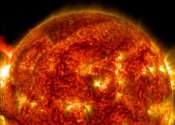Dramatic change in the moon's tilt may help us trace the origin of water on Earth
Astronomers have found evidence that the axis that the moon spins around shifted billions of years ago due to changes in the moon's internal structure. The research could help explain the strange distribution of water ice ...









